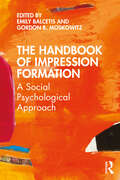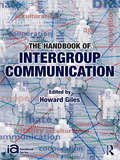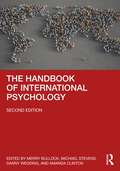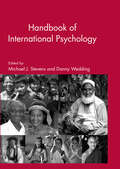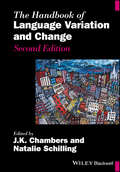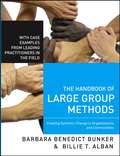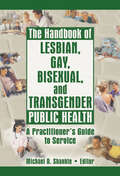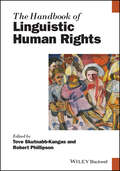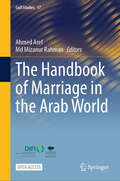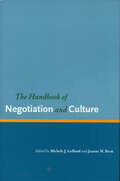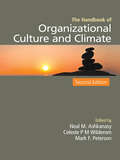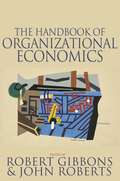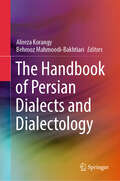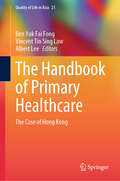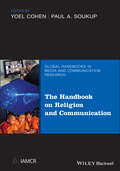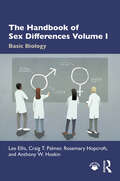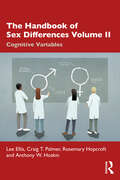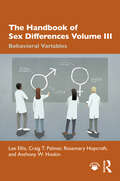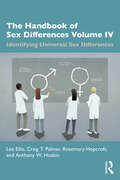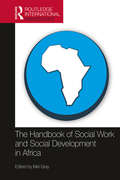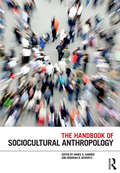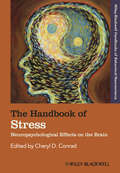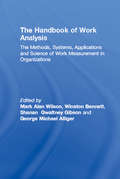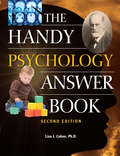- Table View
- List View
The Handbook of Impression Formation: A Social Psychological Approach
by Emily Balcetis Gordon B. MoskowitzPresenting diverse perspectives from eminent scholars and contemporary researchers, The Handbook of Impression Formation contextualizes current and future areas of research in the social psychology of impression formation within a rich historic framework. Affirming that impression formation is at the core of human experience, chapters explore how and why people form snap judgments about others and when those impressions update. They examine the processes through which people infer the reasons for the events they encounter, allowing people to plan for appropriate behavioral responses to social contexts. The research reviewed is informed by the foundational theory of unconscious automatic processes involved in making judgements of other people, pioneered by Professor Jim Uleman who contributes a chapter that suggests important new directions, and concludes the volume by reflecting on the state of the field more broadly. The book explores how certain attributes stimulate categorization, examining current issues around implicit bias, stereotypes, and social media. Chapters cover a range of approaches, featuring personal narratives, presentation of new data and discoveries, comprehensive literature reviews, and contemplations on where the field must go and what questions require focus for progress to be made, calling for even the most advanced scholars to contribute more to the collective investigation of impression formation.This fascinating work provides a solid foundation from which all researchers can build a new and unique program of research, and arms the reader with the intellectual tools they need to chart new theoretical territory and discover aspects of the human experience we have yet to even wonder about. It is essential reading for students and academics in social psychology, and the social sciences more broadly.
The Handbook of Intergroup Communication (ICA Handbook Series)
by Michael Hogg Howard Giles Miles Hewstone Jake Harwood Cynthia Gallois Scott A. Reid John C. TurnerThe Handbook of Intergroup Communication brings together research, theory and application on traditional as well as innovative intergroup situations, exploring the communication aspect of these groups. The volume is organized into four domains – cross-disciplinary approaches to intergroup study; types/processes of communication between groups; communication between specific group types; and arenas in which intergroup communication takes place. Editor Howard Giles worked with an internationally-based advisory board to develop and review content, and the contributors included here represent those scholars doing innovative and well-regarded work around the globe. The "intergroup" umbrella integrates and transcends many traditional conceptual boundaries in communication (including media, health, intercultural, organizational); hence the Handbook will appeal to scholars and graduate students not only in the core area of intergroup communication itself, but across varying terrains of study in communication and beyond, including intergroup relations and social psychology.
The Handbook of International Psychology
by Danny Wedding Michael Stevens Merry Bullock Amanda ClintonThis second edition of The Handbook of International Psychology chronicles the discipline of psychology as it evolves in different regions, from the perspective of those living and working in the countries they write about.This volume surveys the history, methodology, education, training, and future of psychology in more than 100 countries/territories, organized by region and continent. In this thoroughly updated and expanded edition, chapters highlight the important ways in which psychological knowledge and services are contextualized through culture, history, geography, social, and political forces.This comprehensive handbook is essential for students and teachers of psychology, as well as professionals wanting to develop their understanding of psychology around the world.
The Handbook of International Psychology (Oxford Library Of Psychology Ser.)
by Danny Wedding Michael J. StevensWorld events have raised pressing questions of psychology as it is practiced all over the globe. The Handbook of International Psychology chronicles the discipline of psychology as it evolves in different regions, in the hope of reducing the isolated, parochial, and ethnocentric nature of the American profession. It surveys the history, methodology, education and training, and the future of psychology in nine distinct regions across six continents. They represent long histories in the field, such as the United States and the United Kingdom, emerging practices, such as Uganda, Korea and Spain, the lesser-known philosophies of China and histories marked by massive social change, as in Poland and Iran. The editors have carefully selected contributors, as well as an editorial board created especially for this project. Each chapter follows a uniform outline, unifying the volume as a whole, but allowing for the cultural diversity and status of psychology in each country.
The Handbook of Language Variation and Change (Blackwell Handbooks in Linguistics #129)
by Natalie Schilling J. K. ChambersReflecting a multitude of developments in the study of language change and variation over the last ten years, this extensively updated second edition features a number of new chapters and remains the authoritative reference volume on a core research area in linguistics. A fully revised and expanded edition of this acclaimed reference work, which has established its reputation based on its unrivalled scope and depth of analysis in this interdisciplinary field Includes seven new chapters, while the remainder have undergone thorough revision and updating to incorporate the latest research and reflect numerous developments in the field Accessibly structured by theme, covering topics including data collection and evaluation, linguistic structure, language and time, language contact, language domains, and social differentiation Brings together an experienced, international editorial and contributor team to provides an unrivalled learning, teaching and reference tool for researchers and students in sociolinguistics
The Handbook of Large Group Methods
by Billie T. Alban Barbara Benedict BunkerLarge Group Interventions are methods used to gather a whole system together to discuss and take action on the target agenda. That agenda varies from future plans, products, and services, to redesigning work, to discussion of troubling issues and problems. The Handbook of Large Group Methods takes the next step in demonstrating through a series of cases how Large Group Methods are currently being used to address twenty-first-century challenges in organizations and communities today, including: Working with widely dispersed organizations, and the problem of involvement and participationWorking with organizations facing a serious business crisisWorking with organizations in polarized and politicized environmentsWorking in community settings with diverse interest groupsWorking at the global level and adapting these methods for cross-cultural useEmbedding and sustaining new patterns of working together in organizations and communities
The Handbook of Lesbian, Gay, Bisexual, and Transgender Public Health: A Practitioner's Guide to Service
by Michael ShankleGet the comprehensive resource for LGBT public health issues!Public health services for sexual minorities have suffered from practitioners&’ lack of knowledge about sexual or gender orientation, specific health concerns, and inherent system homophobia and heterosexism. The Handbook of Lesbian, Gay, Bisexual, and Transgender Public Health: A Practitioner&’s Guide to Service provides a unique focus on LGBT public health, offering positive direction for practitioners looking for guidance in methods to ensure a healthy community for all while taking into consideration the special needs of sexual minorities. Ignorance and fear by both practitioners and LGBT clients leads to less-than-optimum public health services. The Handbook of Lesbian, Gay, Bisexual, and Transgender Public Health extensively discusses these issues clearly, working to foster cultural competency among public health professionals. This book lays the groundwork for better understanding of LGBT health issues and their relationship to overall public health, then delves into the research on how incorporating LGBT cultural competency can improve academic institutions and continuing education programs. The problem of providing health care access and the health issues burdening each segment of the LGBT community are discussed in detail, all with a focus on providing effective solutions to tough challenges. Clear strategies are also presented for improving city, county, state, and national public health infrastructures and policies. The issue of productive and safe work environments in business and the private sector for LGBT individuals is addressed, along with a close look at the advantages-and pitfalls-of media and Internet resources. Many chapters are illustrated with tables and diagrams; each chapter is exhaustively referenced, includes useful lists of selected resources, and asks questions to spark thought on the issues as they pertain to the reader's circumstances. The Handbook of Lesbian, Gay, Bisexual, and Transgender Public Health discusses: the inequities in health care for LGBT people overt prejudice, discrimination, disdain, or outright denial of services assumption by health professionals of risk factors based on sexual or gender orientation rather than individual behaviors and health history unwitting expression of biases of many public health practitioners the effect of social stigma on public health care services LGBT cultural competency framework for institutions of higher learning and professional organizations LGBT awareness, sensitivity, and competency training sexually transmitted diseases reproductive cancers intimate partner violence noncommunicable diseases among gay and bisexual men &’down low&’ behavior (avowed straight men with spouses having sex with other men) as public health issue AIDS-related malignancies transsexuals and transphobia hormonal therapy sex reassignment surgery (SRS) mental health needs of transsexuals, cross-dressers, and intersex individuals barriers to health care access insurance systems confidentiality of medical records substance use health care issues for LGBT youth and young adults health care needs of LGBT elders recommendations for improvement of health and welfare servicesThe Handbook of Lesbian, Gay, Bisexual, and Transgender Public Health is a one-of-a-kind resource for LGBT public health issues, essential for public health professionals, practitioners, health services professionals, substance abuse counselors, disease intervention specialists, public health advisors, community health service administrators, community based agencies, and community health nurses. Educators in community hea
The Handbook of Linguistic Human Rights (Blackwell Handbooks in Linguistics)
by Robert Phillipson Tove Skutnabb-KangasA groundbreaking new work that sheds light on case studies of linguistic human rights around the world, raising much-needed awareness of the struggles of many peoples and communities The first book of its kind, the Handbook of Linguistic Human Rights presents a diverse range of theoretically grounded studies of linguistic human rights, exemplifying what linguistic justice is and how it might be achieved. Through explorations of ways in which linguistic human rights are understood in both national and international contexts, this innovative volume demonstrates how linguistic human rights are supported or violated on all continents, with a particular focus on the marginalized languages of minorities and Indigenous peoples, in industrialized countries and the Global South. Organized into five parts, this volume first presents approaches to linguistic human rights in international and national law, political theory, sociology, economics, history, education, and critical theory. Subsequent sections address how international standards are promoted or impeded and cross-cutting issues, including translation and interpreting, endangered languages and the internet, the impact of global English, language testing, disaster situations, historical amnesia, and more. This essential reference work: Explores approaches to linguistic human rights in countries of great demographic diversity and conflict Covers cases of linguistic human rights in the Americas, China, Europe, North Africa, India, Nepal and New Zealand, including international minorities, such as the Kurds and the Roma, and the Deaf worldwide. Illustrates how education worldwide has often blocked off minority languages by not offering mother-tongue medium education Presents and assesses conventions, declarations, and recommendations that recognize the rights of Indigenous peoples and minorities. Includes a selection of short texts that present additional existential evidence of linguistic human rights.Edited by two renowned leaders in the field, the Handbook of Linguistic Human Rights is an ideal resource for undergraduate and graduate students of language and law, sociolinguistics, applied linguistics, language policy, language education, indigenous studies, language rights, human rights, and globalization.
The Handbook of Marriage in the Arab World (Gulf Studies #17)
by Md Mizanur Rahman Ahmed ArefThis open access handbook combines multiple theoretical and practical approaches for enabling a nuanced understanding of the phenomenon of marriage in the Arab world. Adopting a holistic, interdisciplinary approach, it provides a framework for the contextual and macro factors surrounding and affecting marriage in the Arab countries. It looks at the different types of marriage, whether traditional or new to the Arab world, and takes a detailed examination of the dialectic of marriage and age. It considers the dynamics surrounding delayed marriages, early marriages, celibacy, marriage costs, and age gaps between spouses. In addition, it examines marital relations vis-à-vis a diverse array of sub-topics, including marital and emotional satisfaction, and violence. It also looks at the relationship between work and marriage, and explores how ‘women’s work’ affects their family relationships and intimacy. Finally, it offers a rich analysis of two core marriage-related issues in the modern Arab world: migration and its positive/negative impacts on the institution of marriage, and marriage in the context of war and conflict, as present in several areas within the Arab region. A sociological magnum opus for social science students and researchers in areas of marriage studies, gender studies, family studies, the sociology of work, peace and conflict studies, human migration, and economics, it is also relevant to policymakers, politicians, social workers, and human rights and migration activists working in the Arab world and beyond.
The Handbook of Negotiation and Culture
by Michele J. GelfandIn the global marketplace, negotiation frequently takes place across cultural boundaries, yet negotiation theory has traditionally been grounded in Western culture. This book, which provides an in-depth review of the field of negotiation theory, expands current thinking to include cross-cultural perspectives. The contents of the book reflect the diversity of negotiation—research-negotiator cognition, motivation, emotion, communication, power and disputing, intergroup relationships, third parties, justice, technology, and social dilemmas—and provides new insight into negotiation theory, questioning assumptions, expanding constructs, and identifying limits not apparent from working exclusively within one culture. The book is organized in three sections and pairs chapters on negotiation theory with chapters on culture. The first part emphasizes psychological processes—cognition, motivation, and emotion. Part II examines the negotiation process. The third part emphasizes the social context of negotiation. A final chapter synthesizes the main themes of the book to illustrate how scholars and practitioners can capitalize on the synergy between culture and negotiation research.
The Handbook of Organizational Culture and Climate
by Neal M. Ashkanasy Celeste P. Wilderom Dr Mark F. PetersonIn The Handbook of Organizational Culture and Climate: Second Edition, a team of leading international scholars presents the state-of-the-art in the field, ten years after the publication of the award-winning First Edition. Following the Preface by Edgar Schein, 33 entirely new chapters document the development and maturing of ideas canvassed in the First Edition, and also offer exciting new perspectives on organizational culture and climate.
The Handbook of Organizational Economics
by John Roberts Robert GibbonsThe definitive introduction to organizational economics, with contributions by leaders in the fieldIn even the most market-oriented economies, most economic transactions occur not in markets but inside managed organizations, particularly business firms. Organizational economics seeks to understand the nature and workings of such organizations and their impact on economic performance. This landmark book assembles the leading figures in organizational economics to present the first comprehensive view of both the current state of research in this fast-emerging field and where it might be headed.The Handbook of Organizational Economics surveys the major theories, evidence, and methods used in the field. It displays the breadth of topics in organizational economics, including the roles of individuals and groups in organizations, organizational structures and processes, the boundaries of the firm, contracts between and within firms, and more.The defining book on the subject, The Handbook of Organizational Economics is essential reading for researchers and students looking to understand this emerging field in economics.Presents the first comprehensive treatment of organizational economicsFeatures contributions by leaders in the fieldUnifies and extends existing literaturesDescribes theoretical and empirical methods used today
The Handbook of Persian Dialects and Dialectology
by Alireza Korangy Behrooz Mahmoodi-BakhtiariThis innovative, investigative, and expansive handbook covers a multitude of angles through which the intricacies of Persian and its many dialects and accents can be examined and parsed with the view of understanding better the devices and paths through which language, and cultural cognizance, operate in tandem. As the first book in English to engage Persian dialects and dialectology on a broad and comprehensive scale, it develops an understanding of the paths through which maximization of the expressive power of words exists in Persian under the rubric of cultural conceptualizations. An insightful and all-encompassing resource for analyzing and augmenting knowledge of Persian linguistics, this work presents a thorough and all-encompassing interdisciplinary treatment of Persian. It is a vital resource for socio- and cultural linguists, as well as anthropologists and Iranists. It is also an excellent reference for historians researching Persian civilization, culture, literature and art.
The Handbook of Personalized Persuasion: Theory and Application (Routledge International Handbooks)
by Richard E. Petty Andrew Luttrell Jacob D. TeenyThe Handbook of Personalized Persuasion provides the most comprehensive and state-of-the-art review of the expansive literature on personalized messaging in persuasion.The book describes what features of people, messages, and contexts are most effective for personally tailored communication, and how this knowledge can be leveraged to improve the influence of messaging in any domain. It also addresses when such personalization can be counterproductive or backfire. Bringing together some of the foremost experts in the area, the book consists of a diverse, global, and interdisciplinary set of scholars who tackle the theory and application of personalized persuasion. Organized into two sections, the first part of this book addresses the many aspects of people to which messages can be targeted, such as the basis of a person’s attitude or the person’s goals or identity. The second part of this book tackles the many important areas of application in which personalized messaging has been examined, such as political and health messaging, consumer advertising, and even online misinformation.This handbook is essential reading for researchers and students in social psychology and across the behavioral and social sciences, while also offering practitioners in marketing, government, and beyond the most cutting-edge insights into how to maximize the influence of personalized persuasion.
The Handbook of Primary Healthcare: The Case of Hong Kong (Quality of Life in Asia #21)
by Ben Yuk Fai Fong Vincent Tin Sing Law Albert LeeThis handbook adopts a transdisciplinary approach to primary healthcare, incorporating a wide scope of perspectives and case studies from Hong Kong in China. It consists of four sections that explore the foundations, practices, development aspects of primary healthcare and systems. The book also pays particular attention to the psychosocial and humanistic contexts of primary healthcare, exploring dimensions such as misinformation in the age of social media in health communication and aspects of resilience in primary healthcare. With contributions from scholars and practitioners in areas that include family medicine, psychology, nutrition, health policy, health education, dentistry, social work, as well as Chinese medicine, it is an expansive presentation of current knowledge on healthcare in the community setting. It is an indispensable reference for policymakers, researchers, advanced students, primary healthcare professionals, community health practitioners, and health managers and educators seeking to collate the practical and philosophical aspects of healthcare, in Hong Kong particularly, but also in Greater China and Asia more broadly. Beyond its relevance to the immediate medical community, it is also a valuable text for researchers in medical law, social sciences, quality of life studies, public policy, business administration, and information technology and health communication.
The Handbook of Religion and Communication (Global Handbooks in Media and Communication Research)
by Yoel Cohen Paul A. SoukupProvides a contemporary view of the intertwined relationship of communication and religion The Handbook on Religion and Communication presents a detailed investigation of the complex interaction between media and religion, offering diverse perspectives on how both traditional and new media sources continue to impact religious belief and practice across multiple faiths around the globe. Contributions from leading international scholars address key themes such as the changing role of religious authority in the digital age, the role of media in cultural shifts away from religious institutions, and the ways modern technologies have transformed how religion is communicated and portrayed. Divided into five parts, the Handbook opens with a state-of-the-art overview of the subject’s intellectual landscape, introducing the historical background, theoretical foundations, and major academic approaches to communication, media, and religion. Subsequent sections focus on institutional and functional perspectives, theological and cultural approaches, and new approaches in digital technologies. The essays provide insight into a wide range of topics, including religious use of media, religious identity, audience gratification, religious broadcasting, religious content in entertainment, films and religion, news reporting about religion, race and gender, the sex-religion matrix, religious crisis communication, public relations and advertising, televangelism, pastoral ministry, death and the media, online religion, future directions in religious communication, and more. Explores the increasing role of media in creating religious identity and communicating religious experience Discusses the development and evolution of the communication practices of various religious bodies Covers all major media sources including radio, television, film, press, digital online content, and social media platforms Presents key empirical research, real-world case studies, and illustrative examples throughout Encompasses a variety of perspectives, including individual and institutional actors, academic and theoretical areas, and different forms of communication media Explores media and religion in Judeo-Christian traditions, Islam, Buddhism, Hinduism, religions of Africa, Atheism, and others The Handbook on Religion and Communication is an essential resource for scholars, academic researchers, practical theologians, seminarians, mass communication researchers, and undergraduate and graduate students taking courses on media and religion.
The Handbook of Sex Differences Volume I Basic Biology (The Handbook of Sex Differences)
by Craig T. Palmer Lee Ellis Anthony W. Hoskin Rosemary HopcroftThe Handbook of Sex Differences is a four-volume reference work assembled and written to assess sex differences in human traits (although findings regarding other species are also included). Based on the authors’ highly influential 2008 book Sex Differences, these volumes highlight important new research findings from the last decade and a half alongside earlier findings. Conclusions reached by meta-analyses are also included. In this, the work’s first volume, findings from thousands of studies are summarized regarding basic biology. Results having to do with sex ratios at birth and traits involving a wide range of bodily features are reported along with numerous complex aspects of biochemistry, neurology, and physical health. The eight chapters comprising Volume I are as follows: 1. Reproduction, Development, and Morphology 2. Anatomical and Physiological Factors 3. Bodily Fluids, Biochemicals, and Biochemical Receptors 4. The Brain: Structure and Functioning 5. Physical Health and Illness Factors 6. Responses to Physical and Chemical Environmental Factors 7. Responses to Stress and to Pain 8. Prenatal Factors The Handbook of Sex Differences is of significant importance for any researcher, student, or professional who requires a comprehensive resource on sex differences.
The Handbook of Sex Differences Volume II Cognitive Variables (The Handbook of Sex Differences)
by Craig T. Palmer Lee Ellis Anthony W. Hoskin Rosemary HopcroftThe Handbook of Sex Differences is a four-volume reference work assembled and written to assess sex differences in human traits (although findings regarding other species are also included). Based on the authors’ highly influential 2008 book Sex Differences, these volumes highlight important new research findings from the last decade and a half alongside earlier findings. Conclusions reached by meta-analyses are also included. This, the work’s second volume, summarizes results from thousands of studies pertaining to cognition, broadly defined. Variables related to perceptual and motor skills, emotions, intellectual abilities, and mental disorders are among those examined. Even sex differences in attitudes, beliefs, preferences, and interests are documented in this volume. The seven chapters comprising Volume II are as follows: 9. Perceptual Abilities and Motor Functioning 10. Emotional Factors 11. Cognitive, Academic, and Intellectual Factors 12. Learning, Memory, Knowledge, and Cognitive States 13. Self-Assessments and States Of Mind 14. Mental Health and Illness 15. Attitudes, Beliefs, Interests, and Preferences The Handbook of Sex Differences is of importance for any researcher, student, or professional who requires a comprehensive resource on sex differences.
The Handbook of Sex Differences Volume III Behavioral Variables (The Handbook of Sex Differences)
by Craig T. Palmer Lee Ellis Anthony W. Hoskin Rosemary HopcroftThe Handbook of Sex Differences is a four-volume reference work assembled and written to assess sex differences in human traits (although findings regarding other species are also included). Based on the authors’ highly influential 2008 book Sex Differences, these volumes highlight important new research findings from the last decade and a half alongside earlier findings. Conclusions reached by meta-analyses are also included. In this, the work’s third volume, findings from thousands of studies pertaining to behavior, broadly defined, are summarized. Traits covered include those involving personality, social behavior, criminality, work, and sex stereotypes. The eight chapters comprising Volume III are as follows: 16. Personality and Behavioral Tendencies 17. Social Behavior 18. Acquiring, Selling, and Consuming Behavior 19. Criminality, Near-Criminality, and Victimization 20. Education, Work, Social Status, and Territorial Behavior 21. Sex Stereotypes 22. Attitudes and Actions Toward Others According to their Sex 23. Ecologically Based Sex Differences The Handbook of Sex Differences is of significant importance for any researcher, student, or professional who requires a comprehensive resource on sex differences.
The Handbook of Sex Differences Volume IV Identifying Universal Sex Differences (The Handbook of Sex Differences)
by Craig T. Palmer Lee Ellis Anthony W. Hoskin Rosemary HopcroftThe Handbook of Sex Differences is a four-volume reference work written to assess sex differences, with a primary focus on the human species. Based on the authors’ highly influential 2008 book Sex Differences, these volumes highlight important new research findings from the last decade and a half alongside earlier findings. In this, the work’s fourth and last volume, two related questions are addressed: Are there universal sex differences (i.e., sex differences found in all societies)? And if the answer is yes, what are they and how can each one be theoretically explained? To answer the first of these two questions, this volume condenses much of the research findings amassed in the book’s first three volumes into summary tables. Then, to help identify likely universal sex differences, three versions of social role theory and two versions of evolutionary theory are examined relative to each possible universal sex difference. Consideration is even given to religious scriptures as a sixth type of explanation. In the concluding analyses, 308 likely universal sex differences are identified. No single theory was able to explain all these differences. Nevertheless, the two evolutionary theories were better in this regard than any of the three social role theories, including the recently proposed biosocial version of social role theory. The Handbook of Sex Differences is of importance for any researcher, student, or professional who requires a comprehensive resource on sex differences.
The Handbook of Social Work and Social Development in Africa (Routledge International Handbooks)
by Mel GrayAll recent books on international social work mention Africa only briefly and few engage with the broader field of development studies. This book focuses solely on the unique African context engaging with issues relating to social work and development more broadly thus enabling a deeper examination and more complex and nuanced picture to emerge. Unlike most academic works, this book highlights multiple practitioner voices, with authors or co-authors that have recently been or are currently practising social workers. As an edited book, it draws from both academic research as well as lived practice experience, supported by strong theoretical positioning and guidance in introductory chapters, drawing on African literature, wherever possible. Looking at case-studies from Lesotho, Botswana, Kenya, Zimbabwe, Ethiopia, Namibia, Uganda, Nigeria, Kenya, South Africa, Rwanda, Zambia and Tanzania and covering established areas of practice such as child protection; working with older people; working with people with disabilities; mental health; and mainstream services targeting women as well as emerging areas of developmental social work practice, such as humanitarian assistance in post-conflict situations; work with immigrants and refugees; and the training of community-based workers, this book takes a future-oriented perspective that aims to move beyond well-worn critiques to envision constructive and sustainable futures for social work and social development in Africa from a critical perspective.
The Handbook of Sociocultural Anthropology
by James G. Carrierhe Handbook of Sociocultural Anthropology presents a state of the art overview of the subject - its methodologies, current debates, history and future. It will provide the ultimate source of authoritative, critical descriptions of all the key aspects of the discipline as well as a consideration of the general state of the discipline at a time when there is notable uncertainty about its foundations, composition and direction. Divided into five core sections, the Handbook: examines the changing theoretical and analytical orientations that have led to new ways of carrying out research; presents an analysis of the traditional historical core and how the discipline has changed since 1980; considers the ethnographic regions where work has had the greatest impact on anthropology as a whole; outlines the people and institutions that are the context in which the discipline operates, covering topics from research funding to professional ethics.Bringing together leading international scholars, the Handbook provides a guide to the latest research in social and cultural anthropology. Presenting a systematic overview - and offering a wide range of examples, insights and analysis - it will be an invaluable resource for researchers and students in anthropology as well as cultural and social geography, cultural studies and sociology.
The Handbook of Stress: Neuropsychological Effects on the Brain (Blackwell Handbooks of Behavioral Neuroscience #9)
by Cheryl D. ConradThe Handbook of Stress: Neuropsychological Effects on the Brain is an authoritative guide to the effects of stress on brain health, with a collection of articles that reflect the most recent findings in the field. Presents cutting edge findings on the effects of stress on brain health Examines stress influences on brain plasticity across the lifespan, including links to anxiety, PTSD, and clinical depression Features contributions by internationally recognized experts in the field of brain health Serves as an essential reference guide for scholars and advanced students
The Handbook of Work Analysis: Methods, Systems, Applications and Science of Work Measurement in Organizations (Applied Psychology Series)
by Winston Bennett Mark A. Wilson Shanan G. Gibson George M. Alliger Erich C. Dierdorff Suzanne Tsacoumis Robert J. Harvey Gregory M. HurtzThis new handbook, with contributions from experts around the world, is the most comprehensive treatise on work design and job analysis practice and research in over 20 years. The handbook, dedicated to Sidney Gael, is the next generation of Gael’s successful Job Analysis Handbook for Business, Industry and Government, published by Wiley in 1988. It consists of four parts: Methods, Systems, Applications and Research/Innovations. Finally, a tightly integrated, user-friendly handbook, of interest to students, practitioners and researchers in the field of Industrial Organizational Psychology and Human Resource Management. Sample Chapter available: Chapter 24, Training Needs Assessment by Eric A. Surface is available for download.
The Handy Psychology Answer Book
by Lisa J. CohenBridging the gap between the entertainment-focused "pop psychology” on television and the dry academic research that is published in journals, The Handy Psychology Answer Book helps answer why humans do what we do through accurate scientific data presented in a lively, accessible, and engaging way. It covers the fundamentals and explains the psychology behind how people deal with money, sex, morality, family, children, aging, addiction, work, and other everyday issues. Fully revised to reflect the latest scientific research--such as the current DSM-5 (Diagnostic and Statistical Manual of Mental Disorders, published by the American Psychiatric Association); the latest neurobiological theories; and the changing face of marriage--this timely reference has expanded to include information sections on the biology and evolution of emotions; technology and adolescence; bisexuality; optimism; autism; as well as a full section on the law, eyewitness testimony and police shootings. Featuring more than 1,500 answers to questions concerning how the human mind and the science of psychology really work such as: How have other cultures addressed psychological issues? Why was Freud so focused on sex? How can I maintain a healthy brain? Is it normal to argue during marriage? Does religion make people happier? How do we reduce social prejudice?
